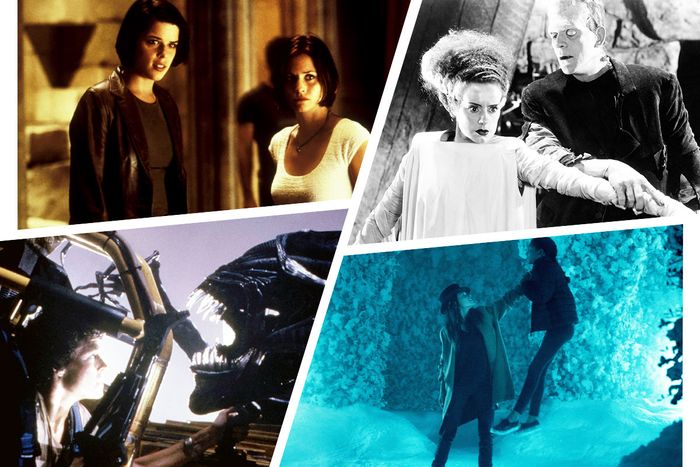
In a franchise-crazy landscape, sequels are a given in pretty much any genre, but they have been a virtual requirement in horror cinema for close to a century. We’ve been resurrecting monster after monster ever since Bride of Frankenstein rolled out in 1935, and there’s no sign of the trend losing steam any time soon. From The Nun II to Saw X to The Exorcist: Believer, the season of horror sequels is once again upon us, carrying on a time-honored tradition that scary-movie fans eat up like Halloween candy.
Of course, some sequels are better than others: You get your duds like Exorcist II: The Heretic and Jaws: The Revenge, but with those misfires come plenty of sparks worthy of inclusion among the best horror movies to be found anywhere. So from the earliest frightful follow-ups to the latest in franchise fare, here are 20 of the greatest horror sequels ever made.
The Bride of Frankenstein (1935)
Universal could have done just about anything for a Frankenstein follow-up and still had a hit on its hands, particularly with Boris Karloff returning in the iconic creature makeup. A humdrum sequel would have been fine, but thanks to director James Whale, what we got was positively revolutionary, a black comedy featuring a talking monster, Ernest Thesiger as the ultimate queer-coded mad scientist, and, of course, Elsa Lanchester hissing like a serpent and sporting horror’s most famous hairdo. It’s funny, it’s scary, and it just may be the best horror sequel ever made.
Taste the Blood of Dracula (1970)
Hammer Studios cranked out a lot of lurid sequels to its revamps (pun intended) of classic monsters in the 1960s and ’70s, and while everyone’s got their favorite, for my money it never got better than Taste the Blood of Dracula. Featuring the great Christopher Lee in the title role (for the fourth time out of an eventual seven for Hammer), the film lives up to its name with a group of wayward aristocrats who decide to sip Dracula’s legendary blood. Comeuppance, of course, ensues in a film that’s surprisingly pointed in its examination of class, privilege, and forces more powerful than wealth. It’s also a cautionary tale for the youths: Don’t make tasting Dracula’s blood into a TikTok challenge, please!
Dawn of the Dead (1978)
It took ten years for George A. Romero to return to the world of Night of the Living Dead, but when he finally came back, he made sure we would never forget it. Dawn of the Dead is famously a film about zombies shambling through a shopping mall, and the ensuing decades have done little to dull the incisiveness of that particular cultural metaphor. But even if you don’t want to take the “It’s a film about dead-eyed capitalism!” ride, you’ll have fun. Gun shops in the middle of malls! Tom Savini as a demented biker! Helicopter decapitations! This one’s got it all.
Halloween III: Season of the Witch (1982)
Two movies into a franchise that had already produced one of the most iconic villains in horror history, John Carpenter and Debra Hill took one of the ballsiest left turns in the history of the genre and gave birth to a gem that’s still gaining new fans four decades later. Halloween III has nothing to do with Michael Myers but does focus heavily on the concept of masks — as tools for Halloween revelry, tools for mass death, and a larger metaphor for the ways the holiday brings out the hidden darkness in each of us. All of that wrapped in a sci-fi-horror package that includes Tom Atkins shouting into a telephone and one of the catchiest jingles ever makes Season of the Witch a worthy detour. If that doesn’t do it for you, you also get to watch a kid’s head turn into bugs.
The Return of the Living Dead (1985)
George A. Romero had already produced a trilogy of zombie films by the time his Night of the Living Dead collaborator John A. Russo dropped his own follow-up, but the wait was worth it. Scripted and directed by Alien’s Dan O’Bannon, The Return of the Living Dead brings its own flair to the gruesome zombie fun, giving us a campier feel, a metafictional hook to kick things off, and, of course, wide-eyed undead creatures demanding, “Brains!!” If you thought things couldn’t get more over-the-top than Dawn of the Dead, you were wrong.
Aliens (1986)
Legend has it that James Cameron walked into the Fox offices, wrote the word Alien$ on a board, and changed cinema forever. Print that legend because no matter how good you think Aliens will be the first time you watch it, it turns out to be better. Jam-packed with Cameron’s visual flair and the extraordinary work of a brilliant ensemble cast, this action-laden follow-up to 1979’s Alien drops the haunted-house-in-space vibe of the original in favor of an all-out creature-feature showdown, and it works like gangbusters. Oh, in case you’re going to try to argue that this is an action movie, not a horror movie: Just watch an Aliens newbie react to Ripley and Newt trying to hide from a Facehugger in a locked room. Case closed.
Friday the 13th Part VI: Jason Lives (1986)
The supposed “final chapter” of Friday the 13th had come and gone and one Jason copycat had already been killed off by the time Part VI hit theaters. It felt like the franchise had nowhere left to go, but then director Tom McLoughlin introduced the world to Zombie Jason and proved everyone wrong. Witty, brutal, and full of memorable kills, Jason Lives isn’t just the best Friday sequel but one of the best slasher sequels you’ll find on the video-store racks.
The Texas Chainsaw Massacre 2 (1986)
The Texas Chain Saw Massacre is notorious for having barely any actual gore in it; after more than a decade of waiting, the great Tobe Hooper decided he was going to change that for the sequel. As bright and gaudy as the original is grim and gritty, The Texas Chainsaw Massacre 2 opens with one of the most unhinged kills ever seen in a mainstream slasher film and just gets stranger from there. By the time it climaxes in the bowels of an abandoned Texas-themed amusement park, you’re so shell-shocked by the cartoonish insanity of it all that you’re driven almost as insane as the characters. In a good way!
Evil Dead II: Dead by Dawn (1987)
Is Evil Dead II a sequel, a remake, or some weird combination of the two? It doesn’t matter when a film is this much fun. Armed with a bigger budget and a deeper bag of cinematic tricks than they had for the original, Sam Raimi and Bruce Campbell went back out into the woods for another tale of one man’s quest to survive a night of demonic madness and brought along every Three Stooges gag they could think of. It has been nearly 40 years, and this movie still ranks as one of the most over-the-top sequels you’ll find in any genre.
A Nightmare on Elm Street 3: Dream Warriors (1987)
Wes Craven and Heather Langenkamp returned to the Nightmare franchise for this ambitious sequel, which grows both the lore of Robert Englund’s Freddy Krueger and the stakes of the battle to defeat him. You can see the difference from the very beginning. Featuring some of the most creative Freddy sequences in the whole franchise (marionettes made of human flesh! Death by television!) and a surprisingly emotional narrative, Dream Warriors is still one of the high points of pure, unfiltered ’80s horror. And it doesn’t hurt that the theme song from hair-metal gods Dokken is still a banger.
Slumber Party Massacre II (1987)
The original Slumber Party Massacre was conceived as a send-up of slasher conventions but played it so straight that audiences maybe didn’t quite get the joke. Enter Deborah Brock’s 1987 sequel, which pits a new group of girls just trying to have a fun night against a killer armed with an electric guitar that doubles as a power drill (in case the phallic symbolism of a simple drill was just a little too subtle for you). It’s a bit of a strange beast, but once you’re tuned in to this film’s frequency, you’ll be in love forever. Plus, as far as I can remember, this is the only major slasher-franchise entry in which the villain gets a full-blown musical number.
The Exorcist III (1990)
William Peter Blatty returned to the world of The Exorcist more than 15 years after the original film to make this adaption of his supernatural horror novel Legion, and in the process, he gave us what remains the best follow-up to William Friedkin’s original (as of this writing, anyway). Featuring a cast of powerhouse character actors led by George C. Scott, The Exorcist III pours on the lurid details while never losing sight of its thematic oomph and even makes time for one of cinema’s most beloved jump scares.
Scream 2 (1997)
Scream is lightning in a bottle, a meta slasher masterpiece that still hasn’t been topped more than 25 years after its debut. You’d think a sequel would be a study in diminishing returns, but while Scream 2 can’t quite hit the highest highs of its predecessor, it emerges as a master class in how to do a follow-up film. From Wes Craven’s direction to Kevin Williamson’s script (last-minute tweaks and all), it’s all killer, no filler. I mean, come on, the movie opens with a woman getting stabbed to death while watching the previous movie. It doesn’t get more meta than that!
Bride of Chucky (1998)
After seven years of silence, the Child’s Play franchise returned for a fourth installment in 1998, and everyone’s favorite killer doll would never be the same. In the hands of the character’s creator, Don Mancini, Chucky rose from quippy villain to camp-driven horror antihero in this film, with a little help from his titular bride, the dollified Tiffany Valentine, and a self-aware script that revitalized the franchise and made Chucky a household name all over again. A classic that spawned a new horror empire for Mancini, Bride of Chucky is proof of one of cinema’s great maxims: Adding Jennifer Tilly makes literally everything better.
Final Destination 2 (2003)
Final Destination is a great idea, not just because of the simple hook of the first film’s premise but because of its endless adaptability. For more than 20 years now, we’ve been watching people die in increasingly elaborate ways thanks to this franchise, but when it comes to follow-ups, the Final Destination films still haven’t topped the first sequel. The logging-truck crash that opens the movie may be the single greatest masterpiece of carnage in the whole franchise, and the film’s clever use of fake-outs to keep you guessing in every single death scene will leave you simultaneously giggling and shrieking on the couch.
The Devil’s Rejects (2005)
House of 1000 Corpses is a wild, carnival-ride-style cross section of Rob Zombie’s horror-addicted brain, but The Devil’s Rejects is proof that Zombie had it in him to be a bona fide horror filmmaker. Following the previous film’s villains as they go on the run and wreak havoc wherever they land, this film is lean, mean, and unforgettably cinematic, with its bright desert daylight and its emphasis on unadorned yet inarguably creative violence. It doesn’t have the bag of tricks of its predecessor, but it also doesn’t need it, and that makes it all the more frightening.
28 Weeks Later (2007)
Danny Boyle’s 28 Days Later is a singular achievement in zombie-tinged cinema, so it makes sense that someone would want to follow up on that world eventually. But how do you follow an act like Boyle? Well, you take the ingredients that made 28 Days Later work so well — deep emotional ties clashing with unspeakable terror — and you apply them to a new ensemble while going bigger with your narrative. The abandoned London that opened Boyle’s film has, 28 weeks later, become an impromptu war zone as the rage virus worms its way back in, and we’ve got a front-row seat to the story of one family just trying to endure. It’s a masterful sequel, and given what came before, that’s really saying something.
The Conjuring 2 (2016)
The not-so-secret weapon of the Conjuring films is the pairing of Patrick Wilson and Vera Farmiga as demon-fighting power couple Ed and Lorraine Warren. To prove it, The Conjuring 2 leans even harder into the dynamic between the husband-and-wife ghost hunters, putting their story front and center as the world around them expands and changes. Shifting the action from the U.S. to England, giving James Wan a whole new slew of jump scares to play with, and introducing spinoff-friendly villains all certainly helped, but we came here to watch Horror Daddy and Horror Mommy fight evil and love each other, and we got it.
Doctor Sleep (2019)
For years, pretty much everyone agreed that Stanley Kubrick’s The Shining was an untouchable masterpiece that should never be franchised. Then along came Stephen King’s sequel novel, which fell into the hands of Mike Flanagan, a horror magician who had already transformed King’s Gerald’s Game from an unfilmable book into a very solid film. In Flanagan’s hands, with a lot of help from a soulful Ewan McGregor and an absolutely magnetic Rebecca Ferguson, Doctor Sleep became a remarkable balancing act between King’s and Kubrick’s opposing sensibilities, emerging as one of the best horror films of 2019 and one of the best King adaptations of all time, not to mention a beautiful sequel to an absolute classic.
Happy Death Day 2U (2019)
Happy Death Day landed with audiences as a high-concept horror comedy that thrived on the rules. Rules work great in slasher movies, but to make a sequel, you have to break them, or at least revise them in ways that let you do more than the same story over again. In the hands of writer-director Christopher Landon, Happy Death Day 2U does exactly that and then some, introducing new time loops, alternate dimensions, and even government intervention into this heady mix of big ideas and brutal kills. It’s a master class in how to go bigger to maximize a horror sequel’s potential, another great showcase for Jessica Rothe, and an absolute blast no matter how many times you’ve watched it. Now give us Happy Death Day 3 (Happy D3ATH Day?) already!




